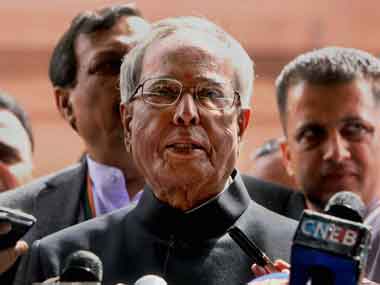The record low of the Indian rupee (INR) against the US dollar (USD) has prompted Finance Minister Pranab Mukerjee to speak out. The FM has promised austerity measures in order to improve government finances, which will in turn strengthen the economy and the rupee (INR). However, even if the FM was serious on austerity the fact is that it will not help the INR.
Austerity in the current context is seen as anti-growth, and if austerity involves cutting back on essential expenditure such as developmental ones, the INR will extend its fall. Austerity to boot is seen as anti-people and the FM’s party will start losing allies leading to mid-term polls, which will further exacerbate the fall of the INR. In fact austerity will only take the INR to Rs 60 plus to the USD sooner than later.
[caption id=“attachment_316512” align=“alignleft” width=“380” caption=“PTI”]  [/caption]
The government at the centre has to realise that reforms are the only tool that will strengthen the economy and the INR. Reforms on subsidies, reforms on taxes, reforms on PSUs and making state politicians accountable to the people is the way forward. Subsidy is the one single factor that has made the government bankrupt. India’s subsidy bill in 2011-12 was the highest ever at Rs 216,297 crore, and this does not take into account the cross-subsidy borne by ONGC, which is over Rs 40,000 crore.
The subsidy bill has made the government overshoot its fiscal deficit target for 2011-12 by 130 bps (1.3 percent). If the government reduces the budget subsidy burden of Rs 190,000 crore, it can easily help correct the INR by 10 percent.
Tax reforms are the second point on the agenda. The Indian government’s tax to GDP ratio has not improved from 10 percent levels over the last many years. There is an urgent need to broadbase tax collections. Implementation of the much awaited GST (goods and service tax) tax will send out the right signals. The government has to crackdown on tax havens and double taxation treaties that are being misused but it should do so quietly and efficiently as the media loves to use it as a reason for market meltdowns!
The government has to make public sector units (PSUs) shareholder and investor-friendly. Using the government’s majority shareholding to milk PSUs for funding the government’s deficit is a complete no-no. Once PSUs are made shareholder-friendly, the government can easily get better valuations and lower its stake in these companies.
The three put together - i.e. subsidy plus tax plus PSU reforms - will be equal to the INR at Rs 40 to the USD, which is a 25 percent plus gain from current levels of Rs 54 to the USD.
There is one more issue that needs to be addressed and addressed fast and that is accountability for taxpayer’s money by the centre and states.
The central government has much higher transparency in its spending than the states. The
central government’s finances come under public scrutiny and at some levels there is a sense of accountability. The RBI prods and pushes the centre to keep its borrowings down while the market punishes the government for poor finances by taking up government bond yields.
In the case of the states, there does not seem to be any accountability. You have a situation where state government entities such as electricity boards and transport corporations are bleeding but state government heads throw free money to the people or spend it on personal glory. State governments are also prodded by the RBI and the markets to straighten their finances, but state governments that are run by local parties are more or less run as a dictatorship leaving finance secretaries toothless.
This has to correct or else there is no difference between an Indian state and an African dictatorship. States are an important part of the government and the center has to work with the states to improve finances.
Lets hope policy makers are listening.
Arjun Parthasarathy is the Editor of www.investorsareidiots.com, a web site for investors.


)
)
)
)
)
)
)
)
)



